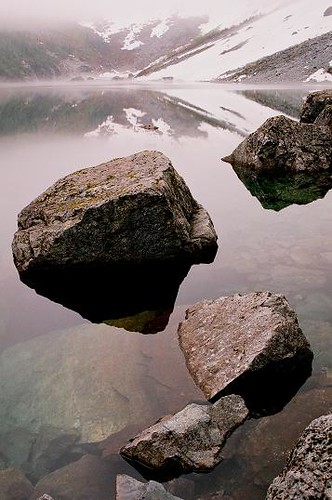|
|
Post by GaliWalker on Aug 29, 2016 20:17:18 GMT -5
Snow Lake, Karakorams (July-August, 2016)A frozen bowl of ice topped by a whipped cream layer of snow, thirty square miles in area and one mile deep, elevation 16,000ft, nestling amidst the forbidding peaks of the Karakorams. An ice cap akin to those at the poles, from which a slew of enormous glaciers are birthed. This was Snow Lake, an awe inspiring display of the mighty forces that shape the most spectacular mountain scenery on Earth. 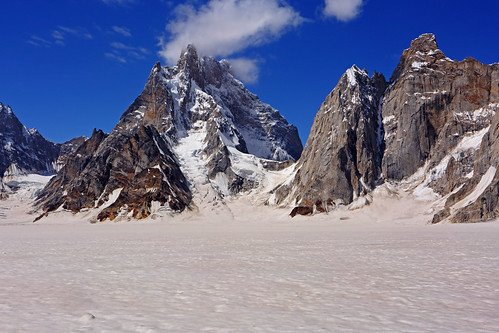 Three years ago on my first trekking trip in the Karakorams, I had skirted the mouth of the Biafo Glacier, as I travelled along the Baltoro Glacier towards Concordia and K2's basecamp. Blown away by the superlative scenery on that trip I was left wanting more. Finally, in late July I was able to return, once again scheduling my trip with the Skardu based company Vertical Explorers. This time, my route was to take me up the Biafo Glacier all the way to its source at Snow Lake. Even though there were to be no 8000m peaks along this valley - unlike the four at Concordia - the mountains were reputedly equally impressive. In order to prepare for the trip, all spring and early summer I slowly worked my way up to 30mi dayhikes. Even though, this amount of fitness wasn't strictly required I wanted to be in good enough condition that I wouldn't have to worry about the effort required and just have fun. Of course, reality has a way of spoiling the best laid plans: five weeks before my first scheduled day of hiking I became the proud owner of a stress fracture of the sesamoid bone, right under the ball of my left foot. Whoops! Two weeks in an air cast followed by three weeks using a special insole in my shoe, no hiking whatsoever, and only light gym work to stay in some semblance of shape. All I could hope for was that when I did get to hike each successive day would become easier...provided that I didn't aggravate my sesamoiditis any more. Part I: Arrival
July 24 - July 26: Islamabad to Skardu
After the long series of flights from the US I arrived in Islamabad, Pakistan, in the wee hours of the morning of July 24th. As the sun rose oppressive heat hit me in waves, an instant reminder that I would need to get used to it as quickly as I could. I also resigned myself to the fact that sweat would be my constant companion from now on during the heat of the day. The next morning, I met up with the other trekking clients, a nice couple from Slovenia, and set off for Skardu. We were originally supposed to be a party of five, but the remaining two - Americans like myself - were unable to procure visas for Pakistan. The bone jarring road journey, after a flattish start, took us through the beautiful Kaghan Valley. This is a narrow, steep-sided lovely green valley. Due to the poor nature of the roads - in a state of constant repair due to frequent landslides - our journey was glacially slow. It was evening by the time we reached the tourists packed town of Naran, (elevation 8000ft), our home for the night. We left Naran for Skardu at 5:00am the next morning, since we had a long day's drive ahead of us. In less than an hour the valley opened up dramatically and became even lovelier. Unfortunately, the road also got worse. Our journey took us past the beautiful Lulusar Lake and then over the 13,700ft high Babusar Pass. Here we were provided with an armed policeman, who joined us in the car for the next couple of hours as we passed through the more lawless region of Kohistan and dropped down to the historic Karakoram Highway. The KKH was oppressively hot and it was grit your teeth and bear it time. 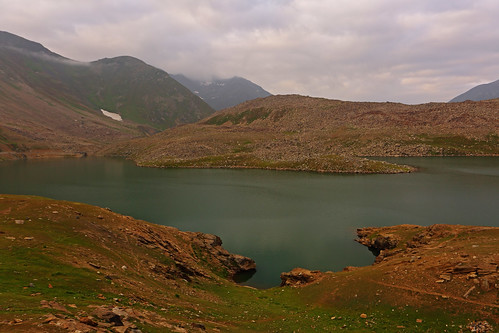 Lulusar Lake Lulusar LakeThe remaining journey to Skardu was nightmarish: a flat tire and mysterious engine troubles had us limping into Skardu at 7:00pm, after a grueling 14hr drive. 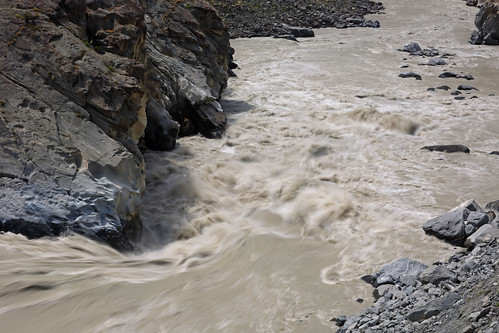 Skardu RiverJuly 27: Becalmed at Skardu Skardu RiverJuly 27: Becalmed at Skardu
The next day, instead of being able to get going we remained stuck in Skardu, while our guide worked on our permits for the trek. With nothing to do we took the opportunity to visit some of the local sights: a visit to the Buddha carvings at the Manthal Buddha Rock (especially important for my Slovenian companions who were Buddhists) and the impressive Sadpara Lake. 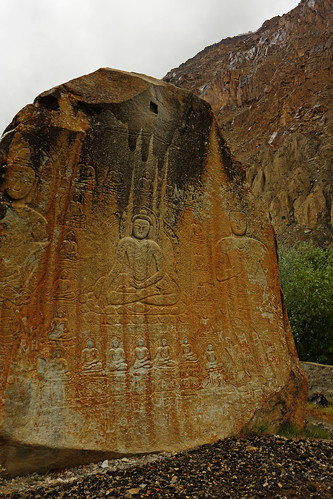 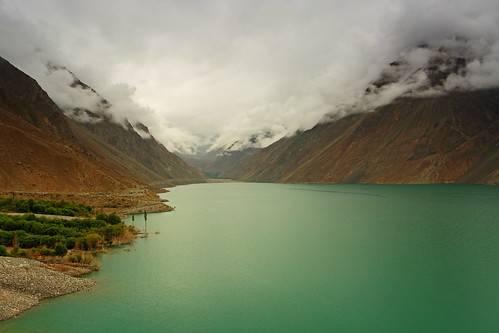 Sadpara LakeJuly 28: Skardu to Askole Sadpara LakeJuly 28: Skardu to AskoleThe jeep drive from Skardu to Askole - the last habitation before we hit the trail - is thoroughly enjoyable. The journey takes you through the gorgeous Shigar Valley: stark and dry, but decorated by lush green villages, islands of fruit trees. ripe golden wheat and corn fields; all of which is made possible by ingenuously constructed aqueducts. 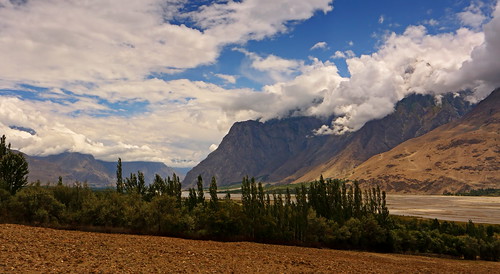 Shigar Valley Shigar ValleyNear the end of the Shigar Valley we took a right turn to head east into the Braldu River valley. Unfortunately, about an hour short of Askole, near the town of Apilogon, a huge landslide had taken out the road. We had to abandon our jeeps (our porters had joined us in a second jeep) and watchfully race across the landslide area, since rockfall was still happening. Once across we piled into a second pair of jeeps to complete our journey. 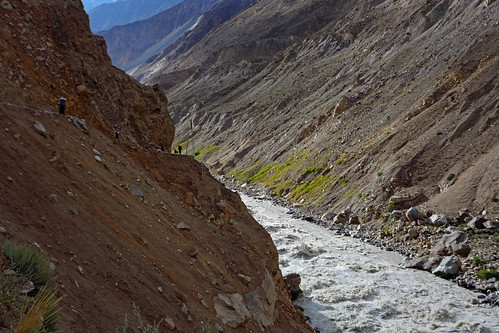 Crossing the landslide area Crossing the landslide areaAskole, elevation 10,000ft, was as lovely as I remembered it from my last time: green and idyllic, chock full of fat and sassy twittering birds, wheat fields, shade trees and inhabited by lovely simple folk. A veritable paradise (at least in the summer months). Oddly enough, we had the entire campsite to ourselves, which made for a quiet and peaceful night, the perfect calm before the furious storm of activity to follow. 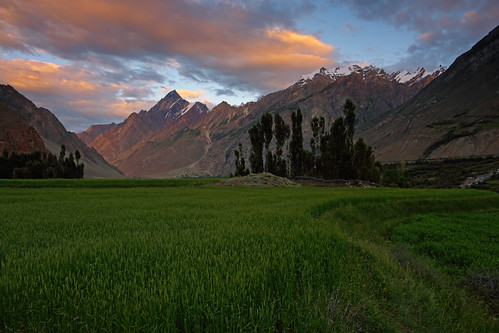
|
|
|
|
Post by GaliWalker on Aug 29, 2016 20:17:59 GMT -5
Part II - The early goingJuly 29: Askole to Namla9mi, 2500ft elevation gain, 6hrs
The past few days, stuck in an assortment of vehicles, having been shaken every which way like one of James Bond's martinis, had me rearing at the bit to get on the trail. Well, we did that in spades since our opening day was a tough one. The day started easily enough, as we made our way along the mostly flat and wide trail out of Askole. Since this was my first bit of hiking in more than a month, due to my recently broken foot, I was a bit anxious to start with. After the first mile, having felt no ill effects, I began to relax and enjoy the walk. The trail took us alongside the tumultuous Braldu River, which was all sound and fury. We got a great view of this anger on the lone steep climb over a headland, after which it was back to more flat hiking. Bakhor Das Peak, which would be in sight for almost the entire trek, loomed high to our right, on the other side of the river. The glaciated peaks of the Baltoro stood like a picket fence in front of us. 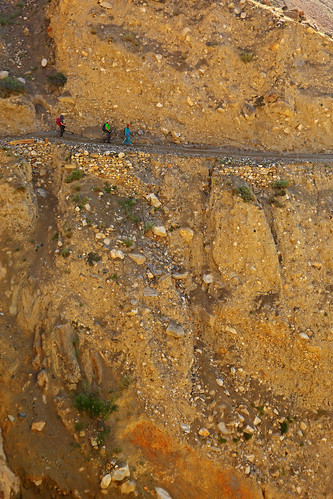 Around 4mi into the hike, we swung left onto the trail towards the Biafo Glacier. From this point on I was on unfamiliar terrain. A half mile further along, just past the ancient Kaiser Polo Ground, the flat nature of the hiking ended rudely, as a steep trail took us rapidly upwards to the aptly named Snum La, or "Sky Pass" in the local Balti language. As we crested the pass we got our first intimidating view of the Biafo Glacier: a turbulent frozen river of ice, covered by boulders and scree, riven by crevasses and dotted with glacial pools, stretching off towards the northwest as far as the eye could see. We were going to be surfing this complex of frozen waves and navigating the maws of icy valleys in just a short while. Unlike my previous Karakoram hiking experience there were to be no easy opening days. From Snum La, we rode a difficult roller coaster trail atop the lateral moraine for a couple of miles: steep side hilling, unstable boulder hopping and continuously up and down on loose dirt. And then it got harder. The trail on the lateral moraine ended abruptly, which meant that it was time to drop down onto the Biafo Glacier. This was a maze of boulder and scree covered ice dunes. I've hiked on plenty of talus/scree routes, but this was something else. Nothing stayed put. Almost every rock moved, mainly because there wasn't a lot of depth to this covering on the ice. Plus, if a rock slid you had to stay with it since it didn't stop moving anytime soon; one had to 'surf' the slide. Eventually I began to get used to the terrain and working out a route through the maze started to become fun. 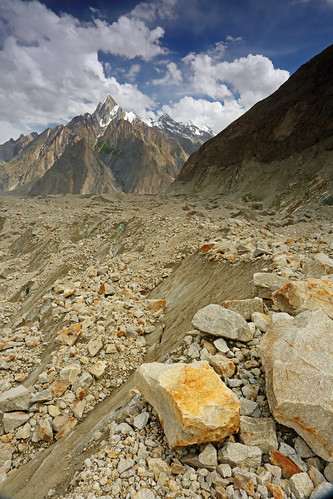
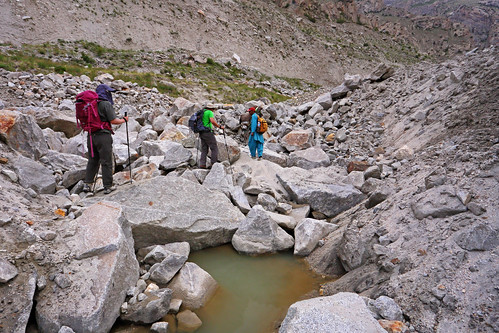 After ~2hrs of moving down the middle of the glacier we swung back to the western end, to leave it for Namla, a green bench overlooking the glacier and our campsite for the night, elevation ~11,300ft. Just as we arrived a group of trekkers returning from Snow Lake also reached Namla. They confirmed that the crossing of Hispar La, a pass above Snow Lake which was originally to be our exit option, was impossible since a huge crevasse had appeared and stymied every trekking group this year. The evening was spent drinking in the scenery: Bullah Peak across from us and peak-a-boo views of the Latoks further up the valley. 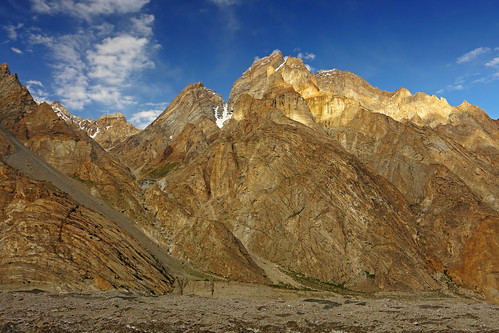 July 30: Namla to Mango4.5mi, 1700ft elevation gain, 3.8hrs July 30: Namla to Mango4.5mi, 1700ft elevation gain, 3.8hrsWeighing in at 3hr 50min of hiking, our second day was short and sweet. We were on our way by 6:45am, relatively early so as to get through the more churned up part of the Biafo before it got too hot. This section was difficult due to tedious boulder hopping and tricky hiking to avoid icy fissures, a game of thread the needle. 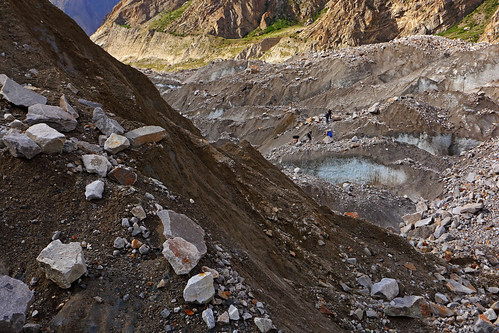 Once we moved into the middle of the glacier it got decidedly easier, since there wasn't a lot of crevasse avoidance required anymore, although it remained extremely rocky. Eventually, even the rocky terrain disappeared and we were able to enjoy faster travel on smooth ice. 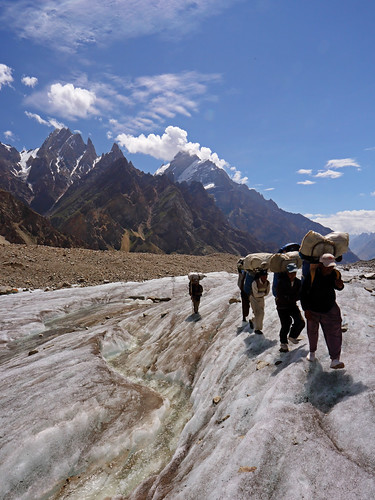 Too soon however, it was time to move off the glacier, for the campsite of Mango. A pattern had begun to emerge by now: while we travelled down the middle of the Biafo Glacier for the most part, all our campsites were on the mountainsides. These glacier-campsite transitions were the hardest parts of our day. 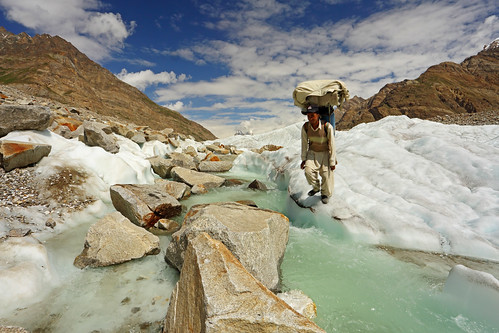 The route to Mango began by crossing a stretch of gleaming white ice for which I donned microspikes, although everyone else seemed to manage without. An emerald green stream ran down the middle, which I found quite pretty. Finding the correct jump off point from the ice had our lead porter (who had already been up to Snow Lake twice this year) cast around for a while, before he was successful in finding the start of the route. Next up was pretty yucky bit of boulder hopping and icy fissure dodging, before we managed to make our way off the glacier and onto the lateral moraine. A steep trail made short work of this. I was hard pressed to keep up with our jack rabbit porters, even though they were carrying up to 80lbs. 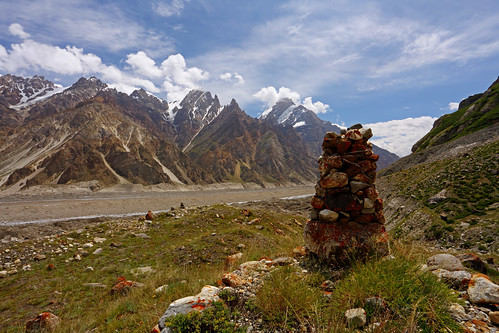 Mango, at ~12,300ft, was a precious green basin in an ablation valley. It lay in the foothills of 17,600ft tall snowy Mango Peak, hemmed in by grassy slopes. A burbling stream ran down one end. There was even a hot spring somewhere close by, although I never saw it. Views of the Biafo from higher up the slopes were lovely. Even though our day had been pretty short, stopping at Mango with enough time to enjoy most of the day was absolutely worth it. 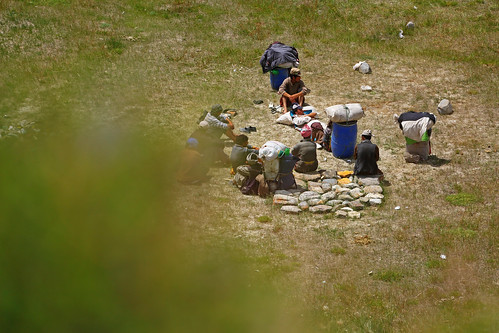 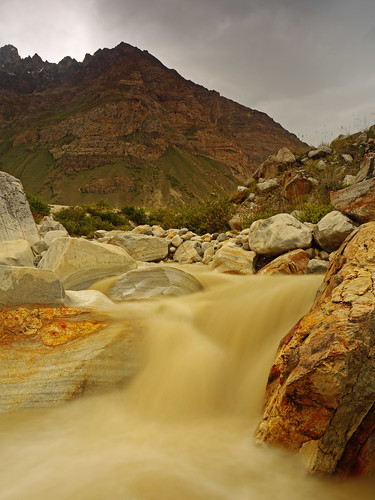 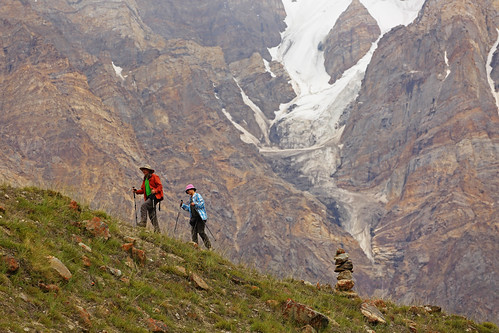 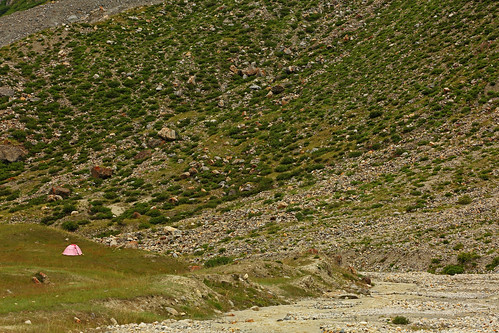 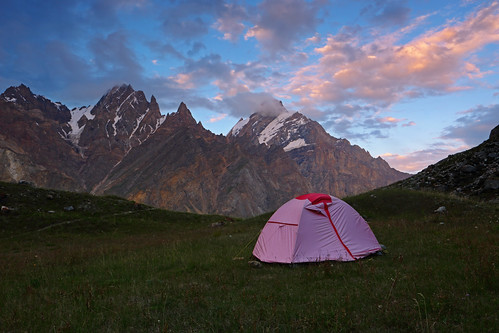 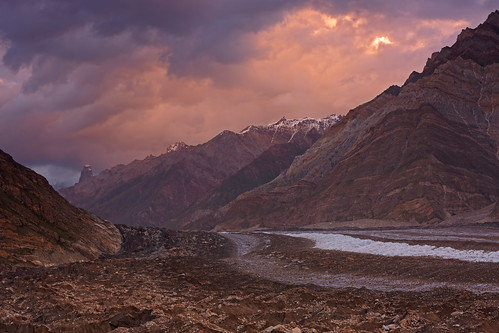
|
|
|
|
Post by GaliWalker on Aug 29, 2016 20:18:39 GMT -5
Part III - The magnificent Latoks and Baintha Brakk, and a lovely ablation valleyJuly 31: Mango to Chiphon6mi, 1200ft elevation gain, 3.8hrs
This was another lovely day of easy but increasingly spectacular hiking. We were on the trail by 6:45mi, only to see all semblance of it disappear in about 5min, as we headed back onto the Biafo Glacier. Essentially, we retraced our difficult steps from the day before until we had regained the smooth ice in the middle of the glacier. Once there, it was smooth and easy travel. I donned my microspikes for the first half an hour or so, after which the icy surface became rougher and traction a lot better. I don't think I used microspikes for the remainder of the trip. 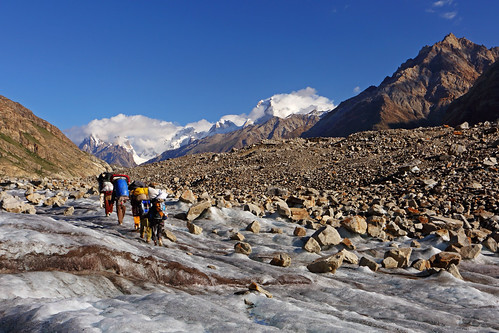 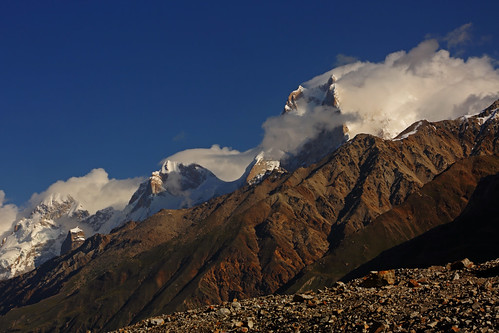 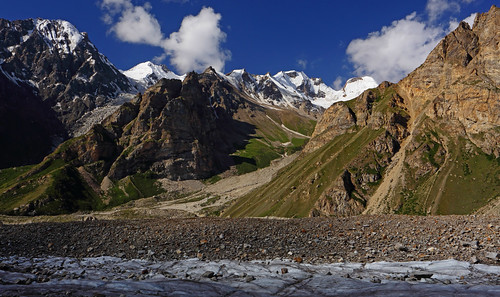 As we moved down the Biafo freeway we began to encounter the occasional crevasse. While these increased dramatically as we moved further up the glacier, for now they hardly impeded us as they were easily avoided by moving laterally. And if we were lazy, we would hurdle them. 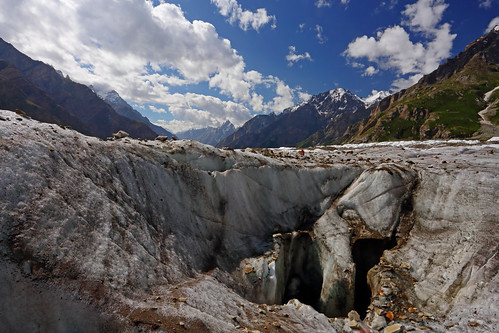 This day we left the Biafo on the far (northeastern) bank of the glacier. Once again, our exit featured a jumble of icy fissures and unstable scree, before we managed to climb atop the lateral moraine via a super steep trail. The trail traversed ingenuously across a cliff face, over a headland and down to an absolutely exquisite campsite, Chiphon (elevation ~13,100ft), in an ablation valley. Flower filled meadows and a sandy beach, beside a wide braided stream, completed the picture postcard setting. Opposite us, on the far side of the glacier, soared the austere, craggy heights of Sokha Lumbu (18,600ft) and Tongo (19,370ft), while behind us the grassy slopes rose up to yet more awesome peaks. 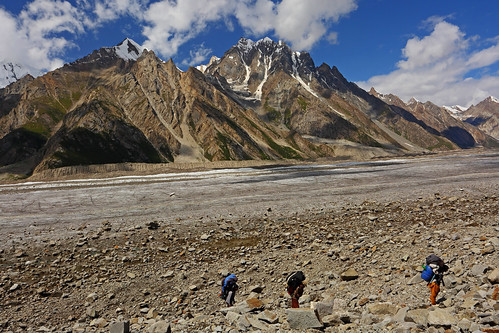 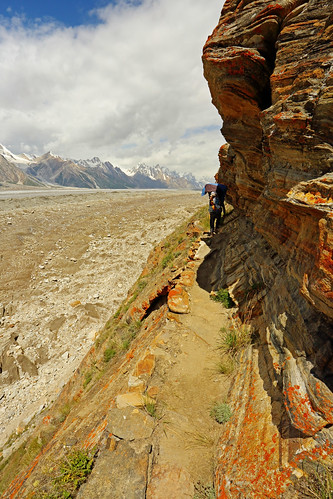 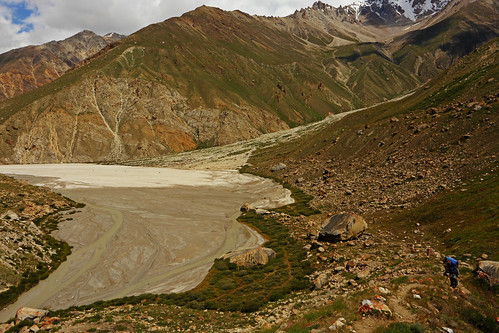 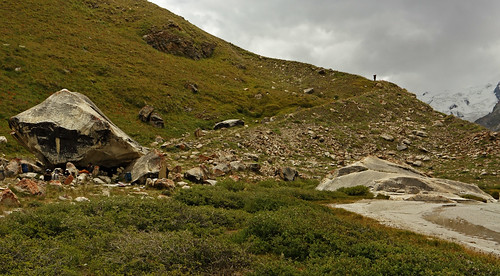 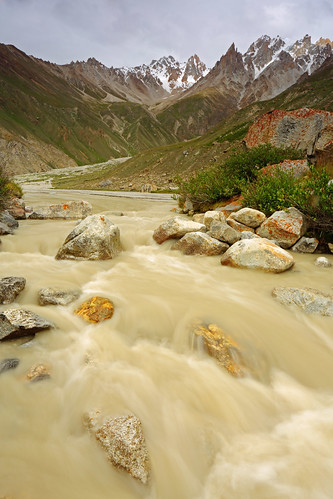 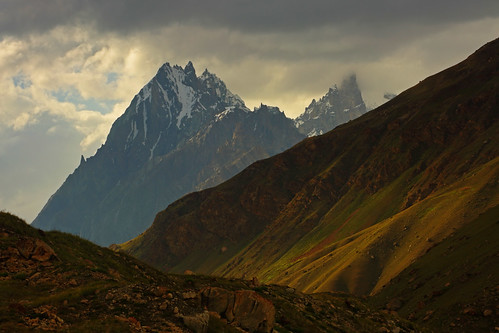 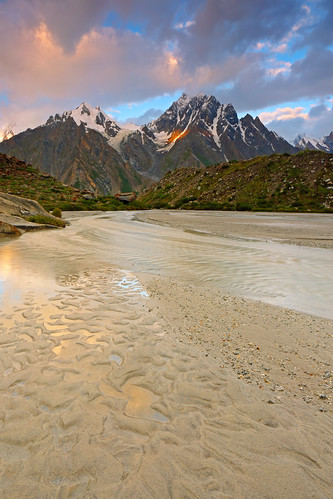 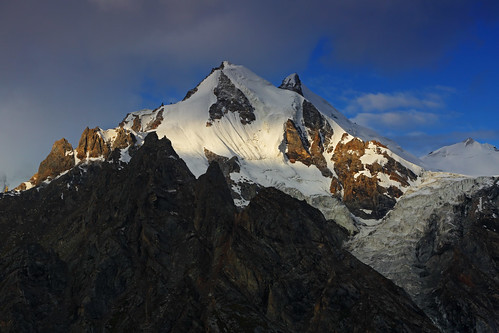 Originally, we were supposed to camp further up the valley, but some of our supplies, which had been shipped atop mules, had yet to reach us. Thankfully, these arrived that evening so everyone was able to relax and enjoy the surroundings. Aug 1: Chiphon to Baintha2.25mi, 300ft elevation gain, 1hr
After an extremely wet and windy night, the morning of the next day dawned bright and beautiful, as is so often the case following a storm. We took full advantage of the pleasant conditions by rambling along the beautiful ablation valley, past small lakes and through flowery meadows to the nearby campsite of Baintha (elevation ~13,450ft), right beside a series of lovely lakes. What a contrast to the hike to-date! 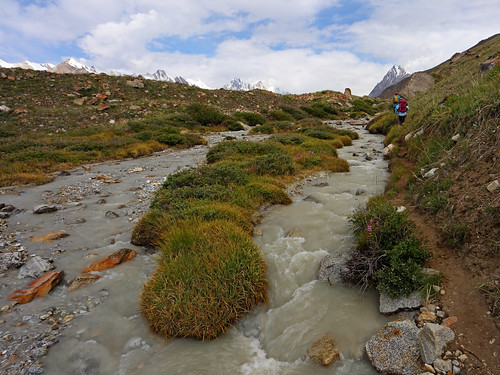 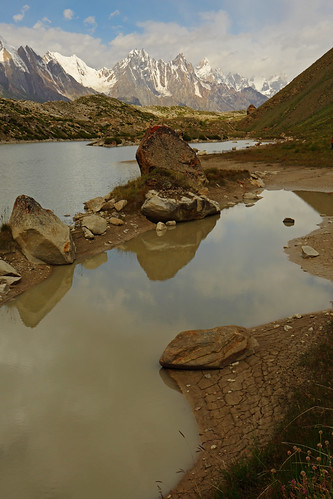 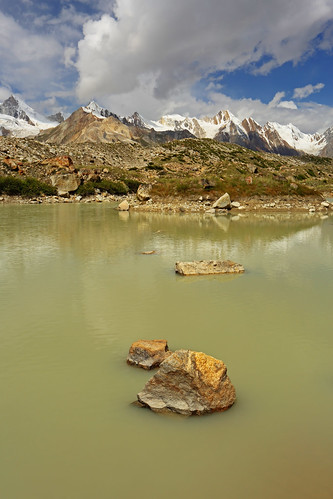 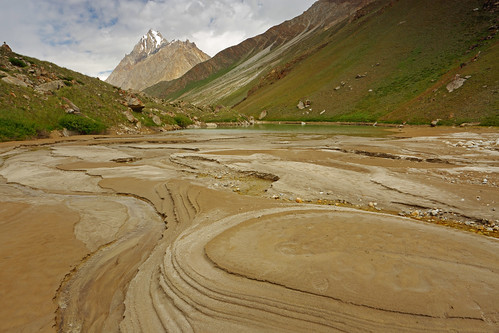 I spent the remaining part of the day climbing up the slopes (along with my personal porter, Zamin, who was keen to join me sans pack) to get a good feel for the valley; basically fooling around to get some elevation gain in (around 800ft worth) and acclimatize myself for the later part of the trek. (I was also able to scout the start of the route to the Latoks for the following day.) Coming back to camp I was informed that we'd just missed seeing an Ibex, which had been hidden from our line of sight behind a rock, but had been visible to everyone else who had been following our progress. 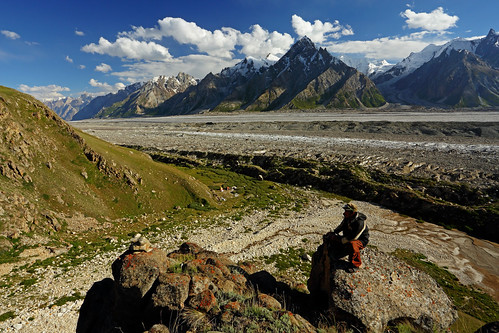 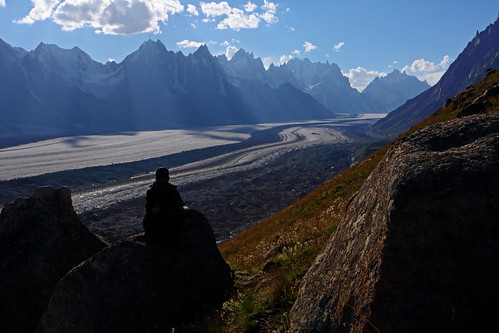 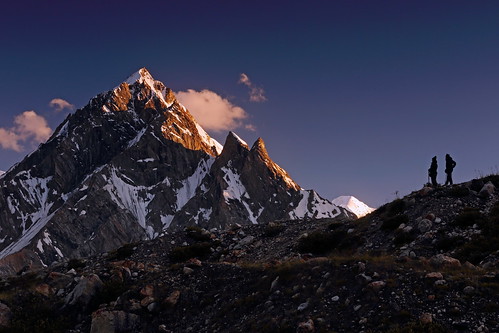 Aug 2: Latoks5.5mi, 750ft elevation gain, 4hrs Aug 2: Latoks5.5mi, 750ft elevation gain, 4hrs
One of my main objectives for the Biafo Glacier trek was to be able to see Baintha Brakk (23,900ft) and the Latoks (23,442ft), which comprise some of the toughest rock climbing challenges. Baintha Brakk (aka the Ogre) in particular, is famous for one of the great survival stories in mountaineering: In 1977, on the first ascent by Chris Bonington and Doug Scott, the latter broke both legs just below the summit in an abseiling accident. It took Scott and his partners (he was joined by two others who were not part of the summit bid) 7 days to get down, during which Bonington broke 2 ribs, and another 5 days for relief to arrive. This day was ear marked for a side trip up a side valley, to get to see the great mountains up close and personal. With our guide, as well as Zamin, who once again was keen to join us, we headed up the lush green ablation valley for 45min, past a series of some really pretty lakes, strung together like pearls in a necklace, to the mouth of the Baintha Lukpar Glacier. 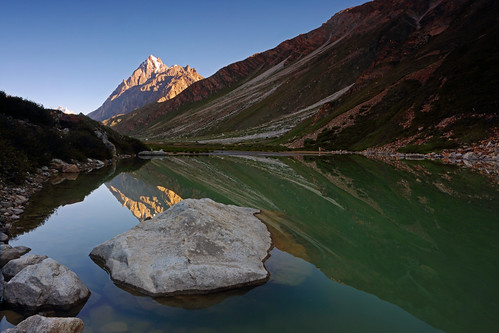 We took a right up a ramp comprised of a jumble of boulders; part of the lateral moraine of the Baintha Lukpar Glacier. As we crested the top of the ramp, we were awestruck by the amazing view of Baintha Brakk (both west and east summits) and the Latoks group. Latok II, in particular, was even more impressive than Baintha Brakk from our perspective, rising knifelike up to the sky. One of the most spectacular mountains I'd ever seen. We wandered up the lateral moraine - not descending to the glacier - through flowers and meadows, drinking the views and atmosphere. 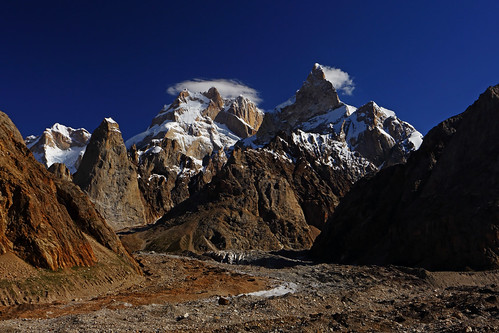 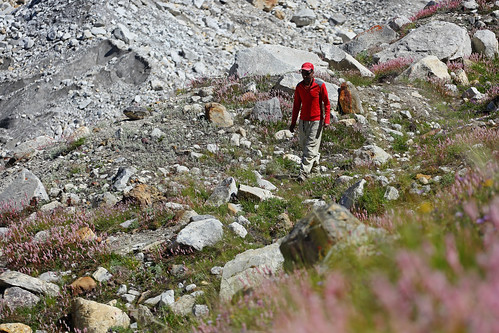 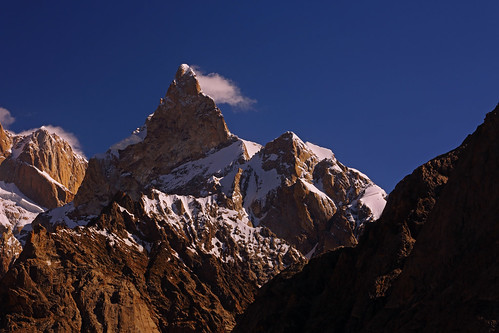 Latok II Latok II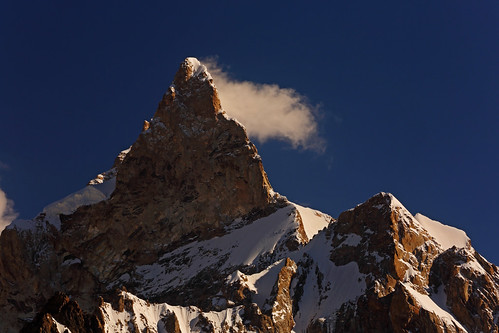 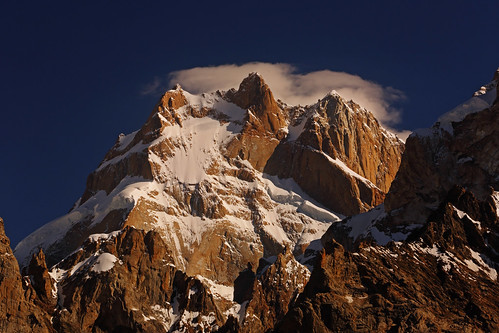 Baintha Brakk (The Ogre) Baintha Brakk (The Ogre)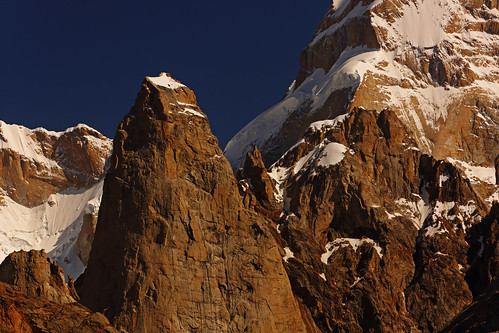 Ogre's Thumb Ogre's ThumbOn the way back to camp I lingered past the lakes, not wanting this magical day to be over. 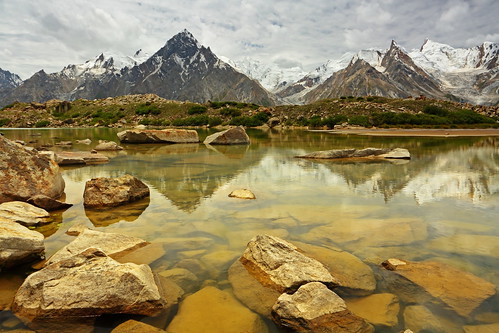
|
|
|
|
Post by GaliWalker on Aug 29, 2016 20:19:13 GMT -5
Part IV – Crevasse dodging on the Biafo, and Snow LakeAug 3: Baintha to Marpogoro7.5mi, 800ft elevation gain, 3.5hrs
Each day continued to match or outdo the one before. After having spent three days in the lovely ablation valley of Baintha it was time to say goodbye to these gentler environs and move on to more rugged terrain. We got moving by 6:45am. 20min of difficult boulder and scree hopping got us back onto the smooth ice in the middle of the Biafo Glacier. It was fast walking on the glacial freeway. Despite that, forward progress was quite slow, because there were numerous crevasses that one had to contour around or jump. I think we spent half our time moving laterally, looking for safe spots to get past the crevasses. Still, it was a lot of fun to stretch my legs, so much fun that I ended up overshooting the exit for our campsite by a good half mile before a whistle from the lead porter brought me back to my senses. Doh! 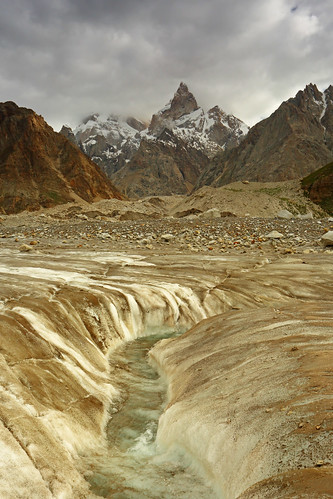 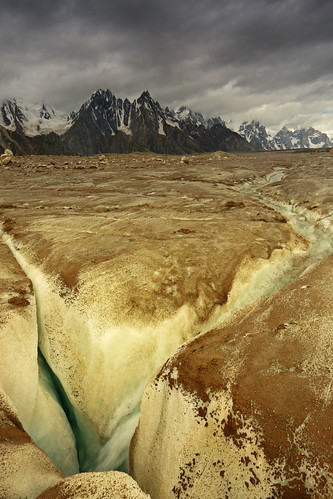 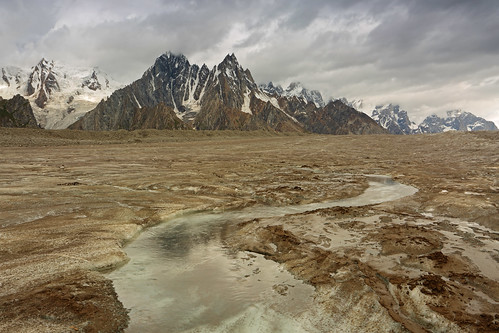 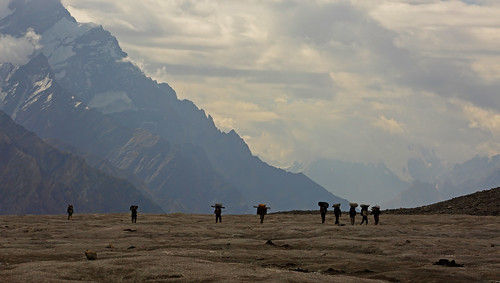 I took my time heading back, to admire the views of the crazy rock spires of Uzum Brakk and Lukpilla Brakk ('brakk' means 'rock' in Balti). 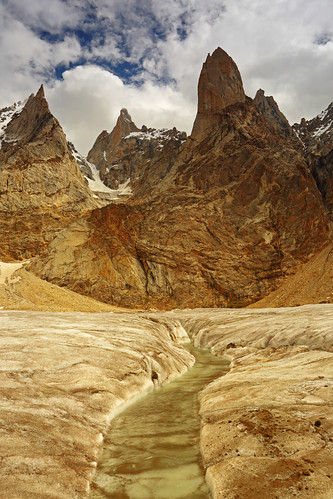 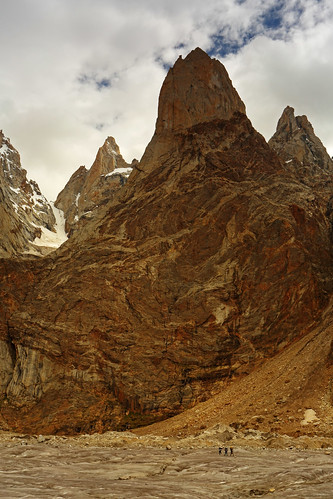 The short stretch over the lateral moraine, to reach our campsite of Marpogoro (elevation ~14,500ft) featured a water garden of lovely glacial lakes. Marpogoro was an expansive sandy area, right under the shadows of Uzum and Lukpilla Brakk. Ghur Peak rose high, across from us on the far side of the Biafo. 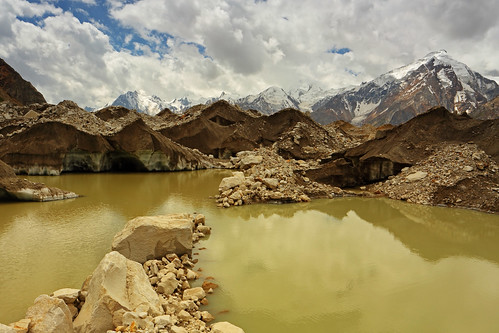 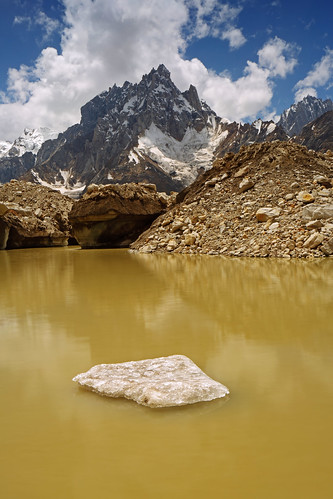 Early evening, I wandered back over to the middle of the Biafo Glacier in the hope of some alpenglow photos, but got chased back by rain. 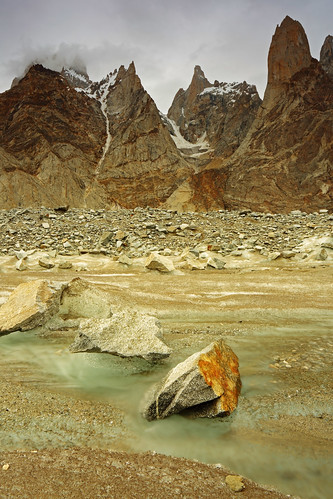 Aug 4: Marpogoro to Karpogoro8mi, 950ft elevation gain, 4.2hrs Aug 4: Marpogoro to Karpogoro8mi, 950ft elevation gain, 4.2hrs
"The Boulder Field of Hell."I woke up to a crisp and clear morning. As I wandered over to check out the glacial lakes near camp, I found them iced over. Despite that, periodically rocks would fall off the ice shelves surrounding the lakes, making a loud crashing sound, reminding us that we weren't on solid ground. 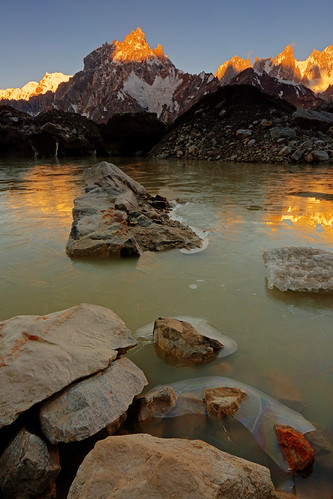 It was 7:00am before we started. After regaining the smooth ice of the Biafo, we embarked upon a zigzag slalom run, wasting huge chunks of time trying to get past the profusion of crevasses. By now, jumping them had become routine; I think I made something like 50 crevasse jumps that day and had to avoid twice that by contouring around them. 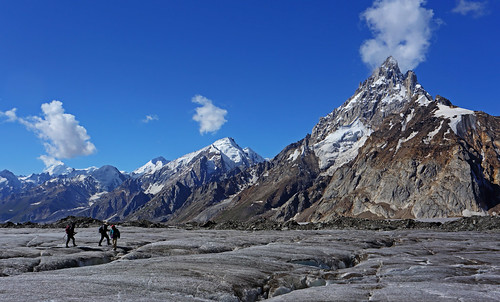 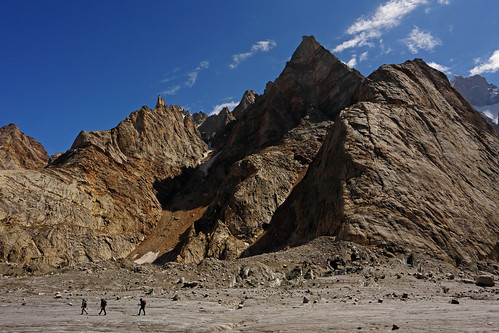 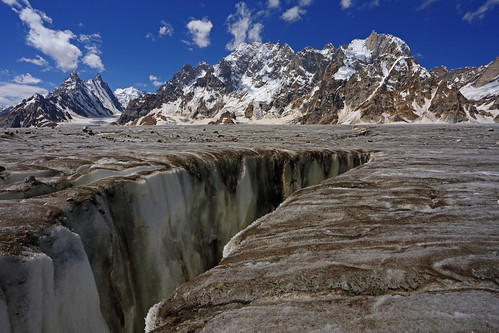 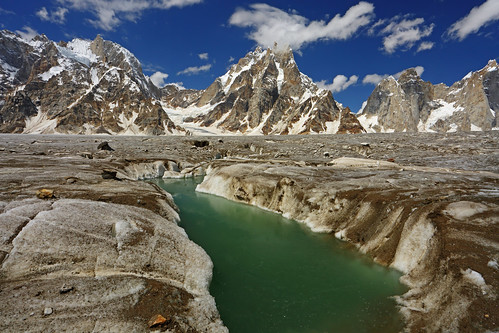 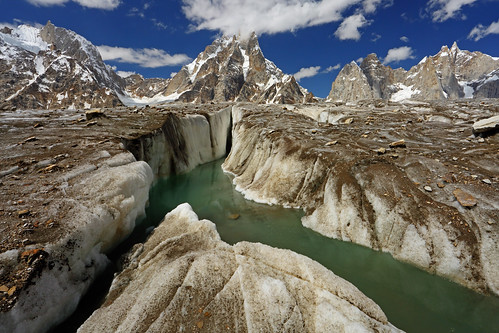 By now we could see the large expanse of Snow Lake, just above a rise in the glacier. However, instead of going over the rise we angled towards the northeastern end of the glacier to hit the base of a talus slope. As I started to climb this, I began to realize that this was pretty much the worst boulder field I had ever been on. It was vast and had numerous dips and climbs. Almost every other rock, however big – and some of them were huge - moved in an unexpected way. Right in the middle of the boulder field, on a rise and right up against a steep hillside was Karpogoro, elevation ~15,200ft. This was a windswept rocky aerie, a cold an inhospitable place. Everyone seemed to be unhappy with this as our campsite, except for me. What can I tell you…? I like white granite, even if I didn't enjoy my walk atop it. Plus, the views were absolutely superb! 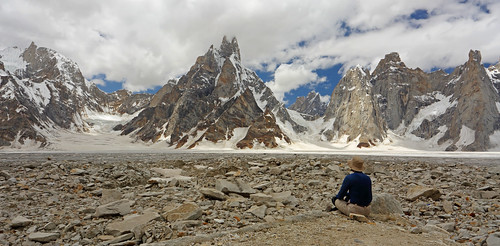 Snow Lake lay like a white snowy blanket to our northwest, surrounded by mountains. On the far side of the Biafo, the peaks of the upper Biafo watched sternly over us all like guardians. From left to right: Ghur Peak, Pamshe Peak, Sosbun Brakk, Sokha Brakk, Solu Tower and finally the snowy triangle of Workman Peak, on the northwest edge of Snow Lake. My favorite, by far, was the absolutely scrumptious Sosbun Brakk (meaning “wall-of-teeth rock” in Balti). It was like Mount Doom on steroids. I've never seen a mountain so jagged. 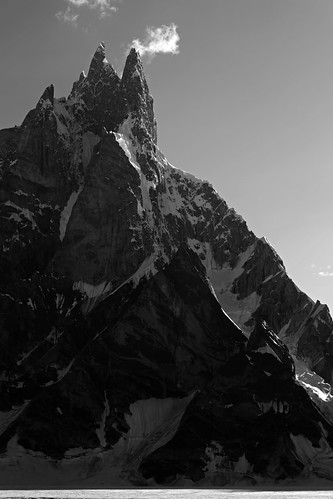 Sosbun Brakk Sosbun Brakk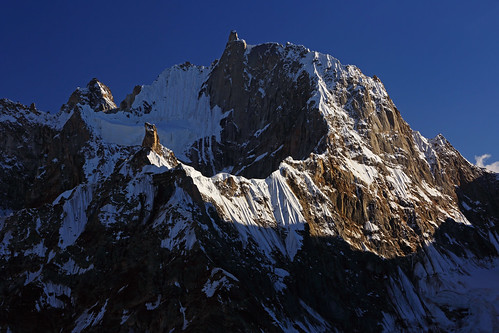 Pamshe Peak Pamshe Peak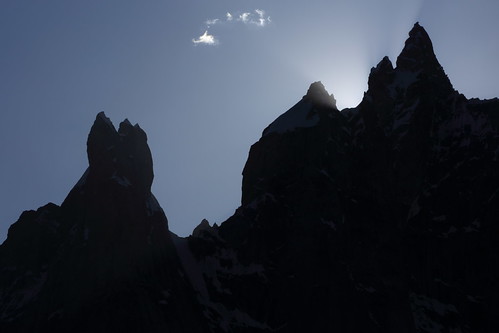 Solu Tower Solu TowerI spent the rest of the day, wandering up and down that blasted boulder field, so much so that I began to figure out how to place my feet so that the unstable rocks wouldn't move so much. 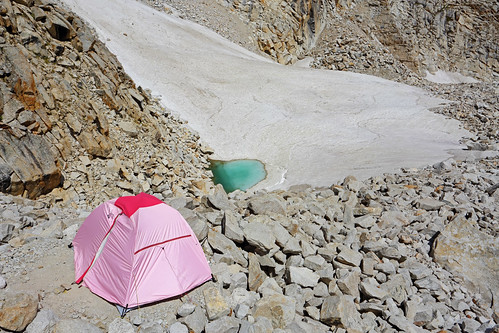 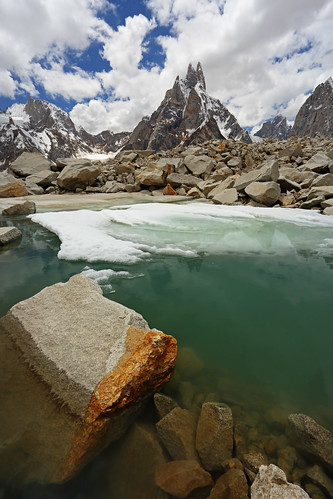 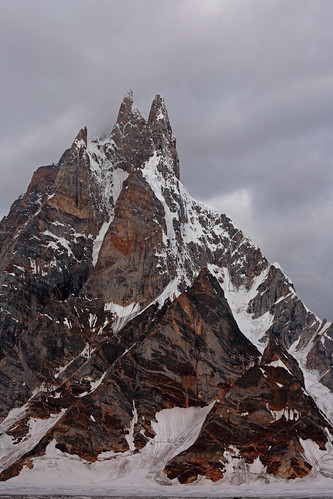 Overcast morning over Sosbun Brakk Overcast morning over Sosbun Brakk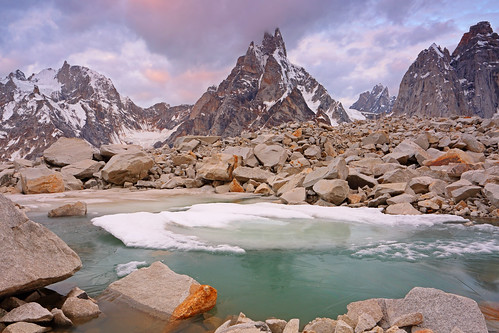 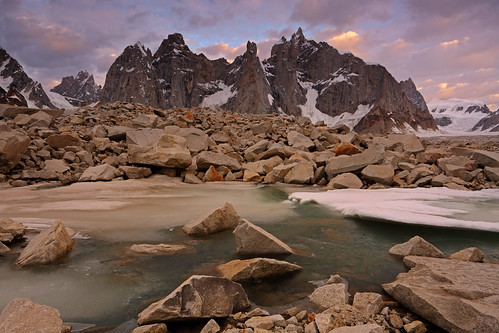 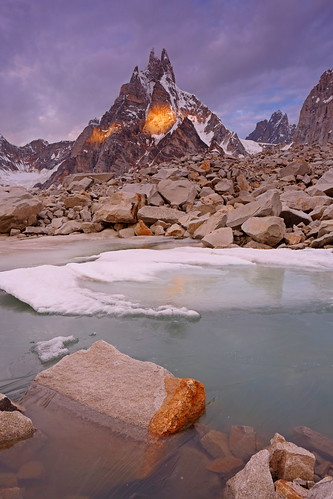 Aug 5: Snow Lake4mi, 500ft elevation gain, 3.5hrs Aug 5: Snow Lake4mi, 500ft elevation gain, 3.5hrsAn ice plug, one mile thick, stuck in the cavernous maw created by a ring of jagged mountains, rising up from the depths like the fangs of a breaching shark. Hide the plug of ice under a thin layer of snow and you have Snow Lake, a vast, deceptively smooth expanse, crisscrossed by hidden crevasses. Before the trip started, our plan had been to cross Snow Lake, ascend up to Hispar La and drop down the other side of the pass onto the Hispar Glacier. Then, take that all the way into the Hunza Valley and civilization. Unfortunately, this year a huge impassable crevasse, 30m wide, had opened up at Hispar La. People were estimating that it would take years for it to close. This news had initially been a crushing disappointment for us, since the Hispar Glacier featured yet more wondrous sights, but by now we had all more or less made peace with the news. So, instead of crossing Snow Lake and camping near the far side below Hispar La, we had decided to just head over into the middle of the 'lake', see the sights and then return back to Karpogoro. We began the day by crabbing our way off the boulder field of Karpogoro and moving along the ice of the Biafo for a short stretch. There were only 5 of us: Nabi, our lead porter who'd already been up to Snow Lake twice this year, Ilyas, our guide, who had been up to camp-II on K2 and had tons of experience, and us three trekkers. The remaining porters remained camped at Karpogoro, since that is where would return to spend the night. Just before we hit the snow covered deck of Snow Lake, we roped up. Nabi led, probing the snow for hidden crevasses, followed by our guide, while I was the last person in the team. Each of us was careful to place our footsteps exactly in those created by Nabi. Soon, he began to uncover crevasse upon crevasse. Once he had done so, he and Ilyas would clear the snow from it so that we could hurdle it, one at a time. Painstakingly, we made our way into the middle of the snowy basin. After one crevasse jump, as I pushed off with my right foot, my entire leg broke through into empty air; and I had jumped into exactly the footsteps of the person in front of me. A little further, Nabi broke through an unidentified crevasse. Each time we were held by the rope. Soon after these two incidents, Ilyas called it good and we stopped and took stock. Up to this point I had not been able to get a good look at the surroundings, even though we stood right in the middle of Snow Lake. Now, we all looked up and tried to drink in as much of the place as we could. We peppered Ilyas with questions about the different routes that led to and from Snow Lake: which way led to Hispar La (“there”)…was Snum La passable (“maybe, but with difficulty”)…had he been with anyone who died in a crevasse fall here (“yes”)… 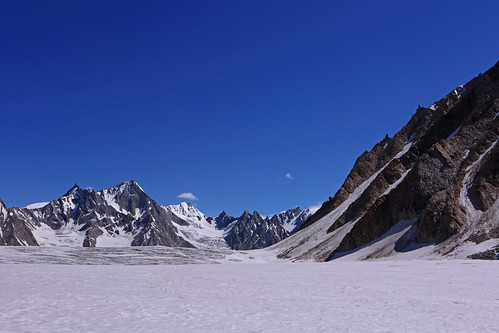 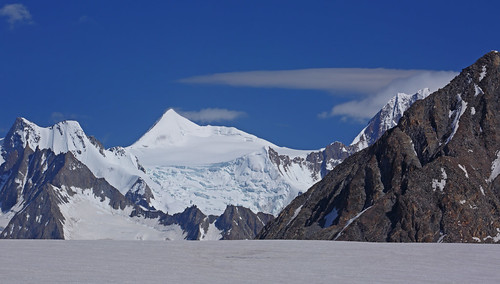 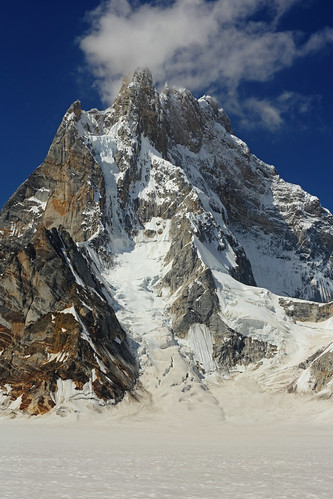 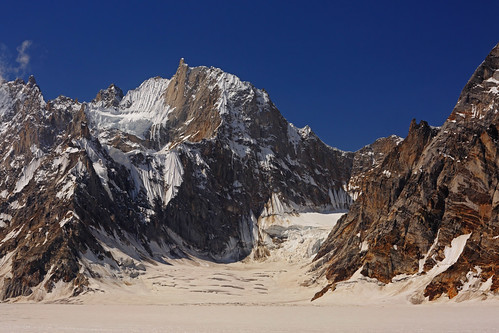 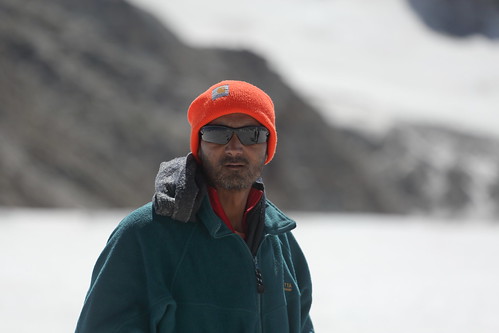 Ilyas, our guide Ilyas, our guide All too soon, it was time to go back. It felt like way too short a time period, but on the return, when one of my Slovenian companions also broke partially through a crevasse, I felt a sense of relief at being soon off the snow. 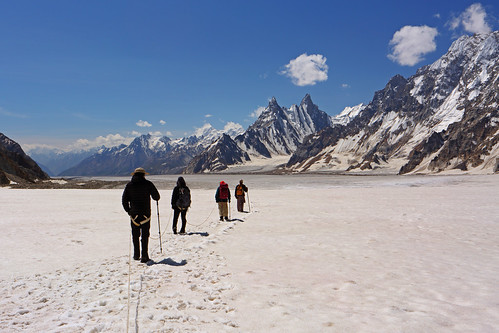 We lazed around in camp that evening. Knowing that we would be on our way back the next day, a psychological switch had got flipped in my head. It was done; I had been to Snow Lake. Now, time to go home. 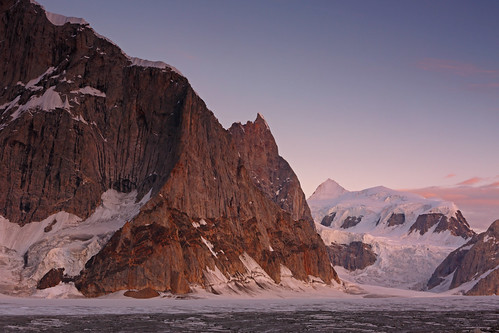 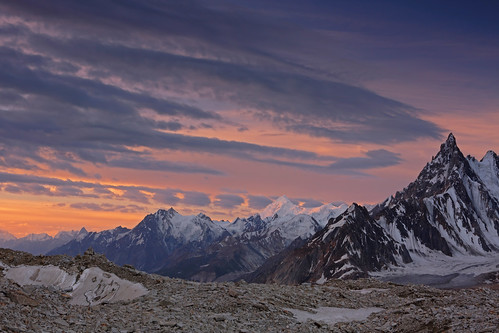
|
|
|
|
Post by GaliWalker on Aug 29, 2016 20:19:46 GMT -5
Part V - Riverdance on the returnWe'd lingered on the way up to Snow Lake, so as to budget plenty of time for acclimatization. Early on, I'd thought that all our hiking days were way too short. However, there had been so much to see that I'd been pretty happy with the pace heading in. Now that it was time to head back down, the gloves came off. We had used up 8 days of hiking; we were going to only consume a little over 3 days for the return. Aug 6: Karpogoro to Baintha14mi, 250ft elevation gain, 6.25hrsAs if to say goodbye, Karpogoro whipped up an amazing sunrise for us that morning. After taking photos of it in camp, I headed off before everyone, since on the way in I'd spotted a nice shooting location at a snow-melt pool, located near the beginning of the Karpogoro boulder field. 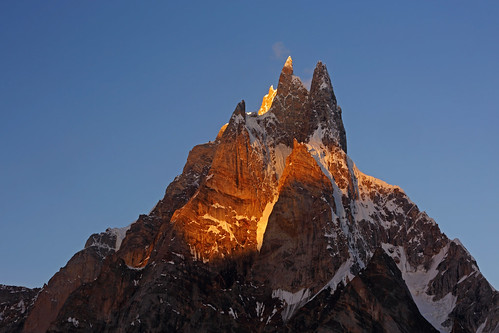 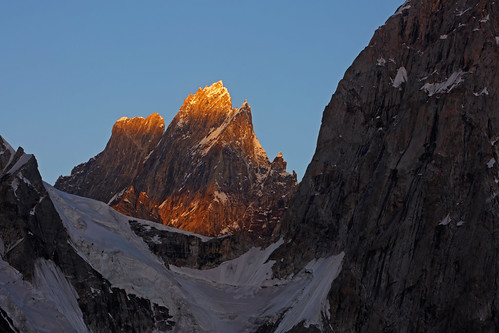 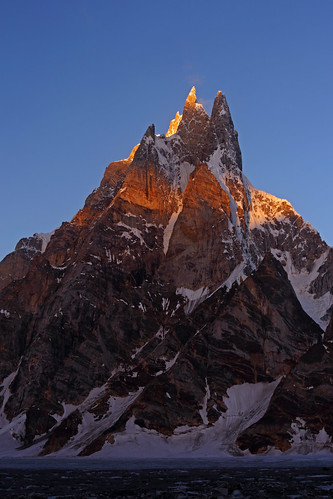 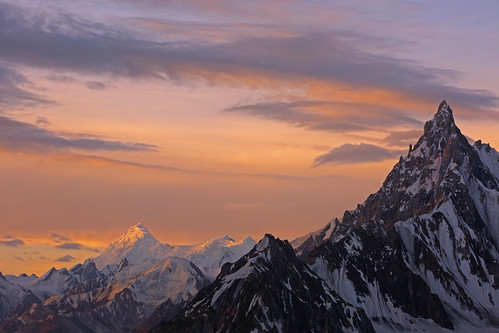 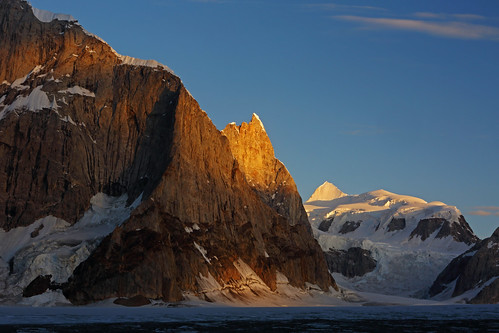 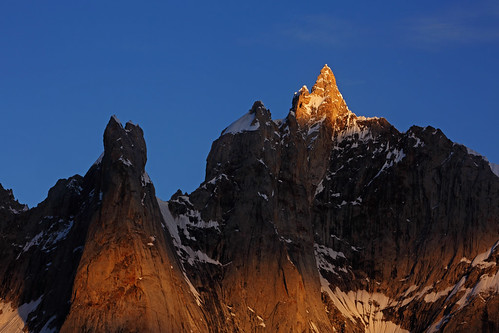 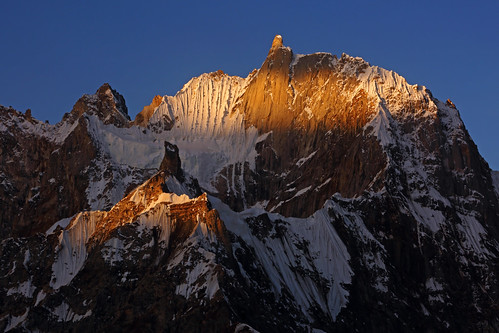 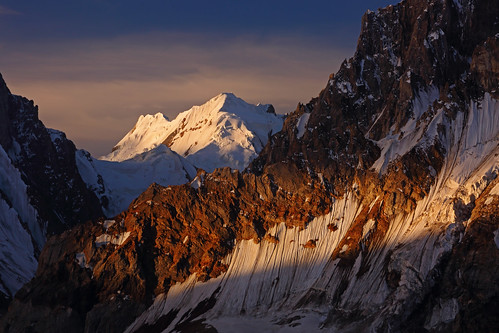 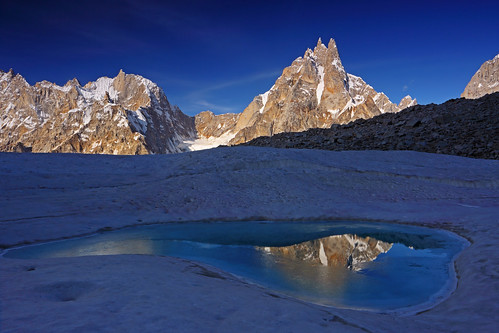 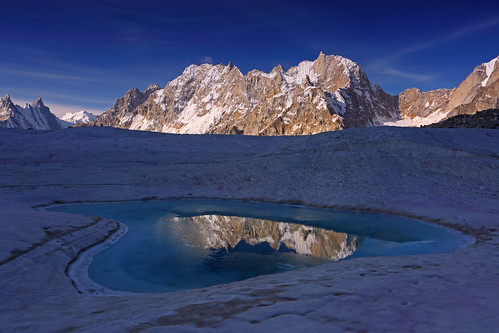 I packed up my camera gear as the porters reached me, after which we raced down the glacier together. 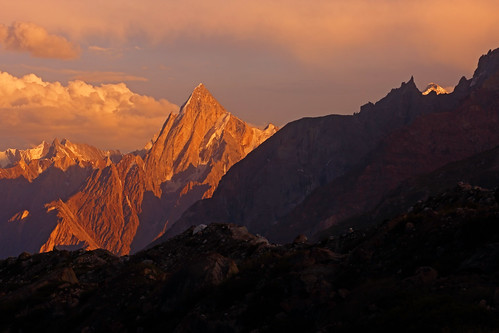 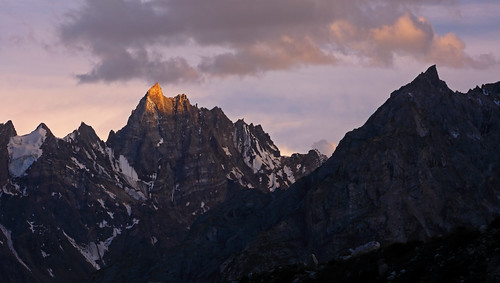 The porters' Riverdance The porters' RiverdanceA few words about the porters: I loved my time hiking with the porters. Since I'd also booked my previous Karakoram trip with Vertical Explorers I was already familiar with some of our porters when I started. e.g. Sardar Hasan - the porters' manager and chief rolled into one - had stayed in touch with me since my first trip. Once he learned that I was coming he had specifically insisted on joining us for the Snow Lake trek, which he had last been on 15yrs ago. It was surprising how quickly I was able to make friends with the rest of them. Since I was a bit quicker than the remaining clients I hiked mostly alongside the porters, while our guide stayed with the others. This was an extremely fun as well as eye opening experience for me. The more time we spent hiking together the more it sunk in that I was in the company of some of the finest athletes I'd ever seen. As far as I could tell, our porters only needed to stop to rest their shoulders, because of the heavy loads they were carrying. They maintained the same speed on the flat bits, where I could keep up with them, as they did on the harshest of terrains, where I would always drop back. Crevasse jumps, hopping ankle twisting boulder fields, negotiating steep and loose climbs or descents, traversing knife-edged icy ridges…nothing slowed them down. Whereas I would be knocking rocks right and left as I strained to keep up with them, they floated serenely over them, all the while wearing an assortment of sneakers or sandals. Watching them move was like watching poetry in motion. (Incidentally, when I asked they told me they were so smooth because their thin footwear allowed them to feel the terrain better, whereas my boots didn't. I think they only said this to be polite.) 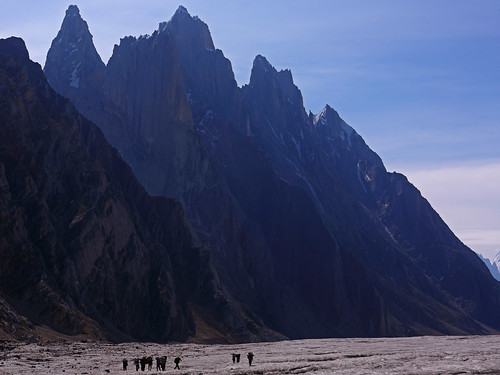 Here's one of my favorite moments while hiking with the porters. This was on our first day of the return. The porters were pushing it, as was I. We were heading down the glacier, where the terrain was flat so I could mostly keep up. Yawning crevasses had us haring right and left in avoidance, or picking an optimal line so as to make jumping them easier. I was with a group of 4 other porters. Due to the heavy loads they carried they had their arms crossed over across their chest, to hunch their shoulders. They were singing as they sped down the glacier. A 3ft wide crevasse appeared ahead of us. While I paused to take stock, none of the porters did. Like a well oiled machine each porter moved right or left to pick his line and soared effortlessly and smoothly over the crevasse, without a break in his stride. All the while, the singing continued and the arms remained crossed. The Riverdance of the porters. Oh yeah, in contrast I did my best impression of an embarrassed duck while conducting my own crevasse jump. Aug 7: Baintha to Namla11.75mi, 550ft elevation gain, 6.5hrs
This was another long day. It was easy enough to begin with, but the last 2hrs were on the harshest terrain of the day: negotiating the maze of the churned up portion of the lower Biafo, just below Namla. Think of a rumpled ice rink and then try to negotiate it on roller skates. This was how it felt trying to walk atop the unstable boulder strewn deck of the glacier. 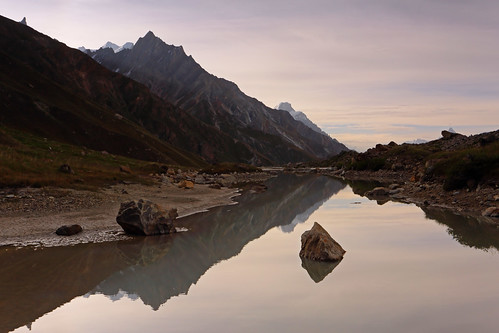 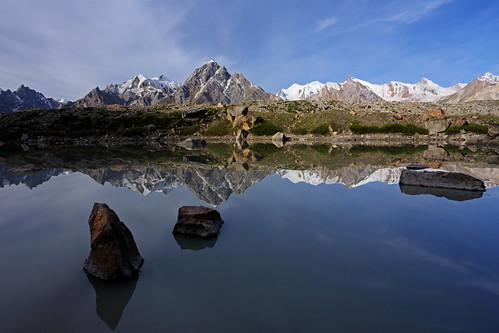 Nabi, our lead porter was a wizard in reading this terrain and avoiding getting cliffed out, so I stuck to him like glue. Consequently, we reached Namla an hour ahead of the rest, then relaxed and watched with some amusement as the rest (porters, and even our guide and clients) tried to extricate themselves from the maze. 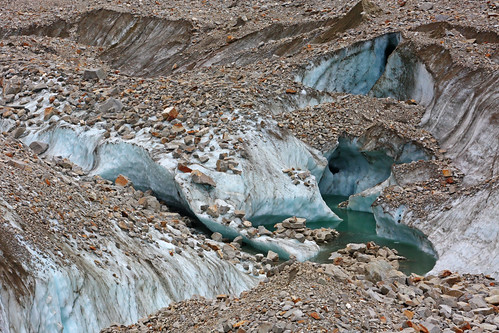 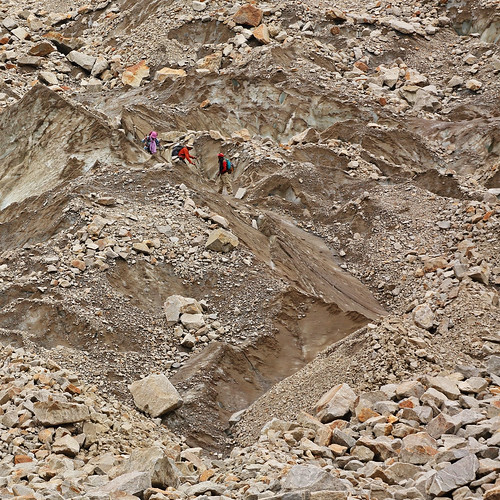 I spent the rest of the day exploring the slopes above Namla. We were treated to a superb light show on Bullah Peak that evening. 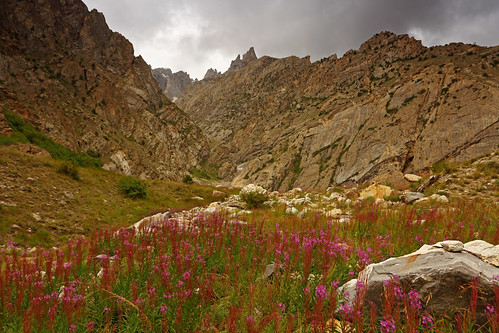 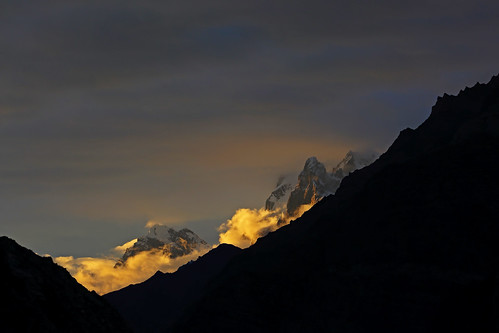 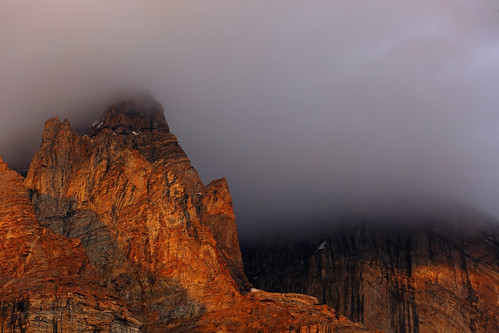 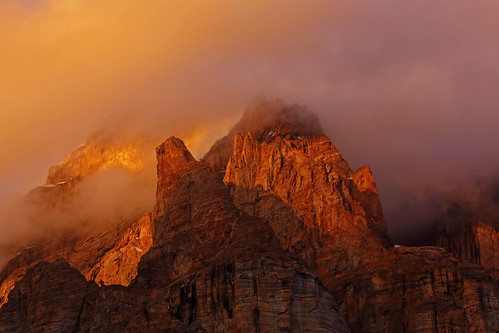 Aug 8: Namla to Kaiser's Polo Ground4.5mi, 500ft elevation gain, 2.75hrs Aug 8: Namla to Kaiser's Polo Ground4.5mi, 500ft elevation gain, 2.75hrs
Instead of finishing off the hike in Askole, we decided to stop a few miles of flat walking shy, at Kaiser's Polo Ground. This would still leave us plenty of time the next day to make it to our jeeps and onward to Askole, whilst providing us with a lovely location to camp in. After enduring the first 1.5hr of our day, in traversing the last of the lower Biafo's difficult ice dunes, it was back on trail. I cheered as we hit the trail, but soon realized that I'd forgotten how hard this part along the lateral moraine was: Lots of up and down, loose dirt traversing and talus hopping ensued, before we crested Snum La - Sky Pass - and reached more regular trail. In just a few more minutes we were at Kaiser's Polo Ground, our home for the night. 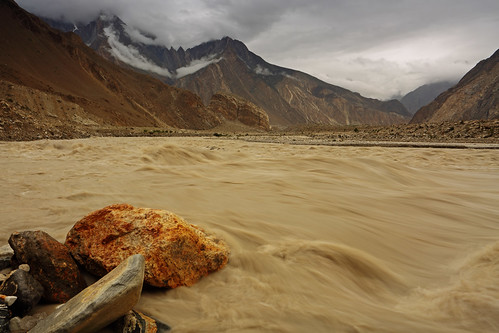 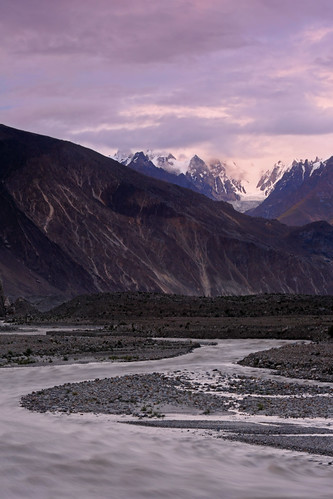 That afternoon, as thanks to the porters (13 of them), I took over the kitchen tent and cooked some omelets for them. I can't tell you how much pleasure that gave me. Aug 9: Kaiser's Polo Ground to Askole4.5mi, 550ft elevation gain, 1.75hrs
Our last day of hiking: A wide, flat trail, super easy and fast. Askole - civilization! - was a sight for sore eyes. However, we only had time for a cup of tea before piling into our jeeps for Skardu. 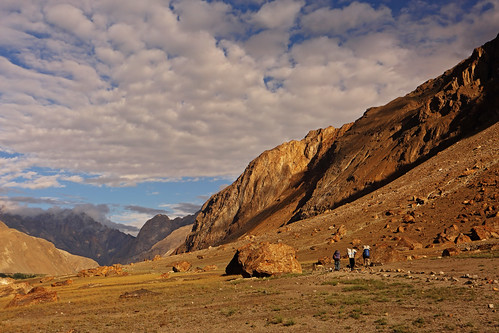 Conclusion and logistics Conclusion and logistics
This was my second trip in the Karakorams, the World’s most beautiful mountain range. Obviously, comparisons with my first visit, to Concordia and K2’s basecamp, were to be made. Everyone else on the Snow Lake hike said who had done both said that this one was better. For me, it was a draw: the K2 trek has the better mountains (basically because they’re taller), but the Snow Lake trek has more variety (more lakes, more greenery) and is more photogenic. The K2 trek is slightly more strenuous, but the Snow Lake trek is far more dangerous. Either way, one can’t go wrong in one’s choice of trek. The only problems with either of the treks…? Budget a few months afterwards, to get over withdrawal symptoms! As before, I scheduled my trip with the Skardu/Islamabad based company Vertical Explorers, who basically deals with foreign clients. The strength of this company is the wonderful porters and guides they employ: helpful, respectful and with the clients best interests and safety in mind. We encountered some logistical issues, but really none worth mentioning on the trek itself, so overall I was very satisfied. Since I had booked my trip from the US, I possibly paid about a third more than if I had tried to arrange it through a Pakistani company who deals with local Pakistani clients. However, the price was extremely reasonable anyway, and I would have had to jump through many more hoops if I had attempted the latter option. (If you are interested, the prices are available for each trek on the Vertical Explorers website: http://www.vepakistan.com) The most aggravating parts of the trip are the drives to and fro Skardu, especially when there is a flight available. Unfortunately, there is a lot of uncertainty around that flight, which makes relying on it a non-viable option, especially when you are on a tight inflexible schedule. The reason is that Skardu has a small airfield, too small for jet aircraft to land on. Thus, the planes which fly to and from Skardu are propeller driven ones, which can’t fly over all the mountains that cover the northern part of Pakistan. They must fly through some of the valleys and thus are at the mercy of the weather. There is almost always a long backlog of passengers waiting for their flights out of Skardu. My take: suck it up and stick to the drives; who said trekking in the Karakorams would be a picnic?
|
|
christopherrobin
Forum Elder
“People say nothing is impossible, but I do nothing every day.”
Posts: 259 
|
Post by christopherrobin on Aug 30, 2016 6:29:30 GMT -5
Wow. Amazing. Is this the Nat Geo forum? Beautifully done!
|
|
|
|
Post by GaliWalker on Aug 30, 2016 7:46:42 GMT -5
Thanks, christopherrobin. I'd been working up to this trip since late last year, mentally and physically preparing myself. Now, for a few weeks I'll probably go through the motions of doing some local hikes, basically to stay in shape, so that by the time fall comes around and I'm over my withdrawal, I'm not out of shape.  |
|
ki0eh
Forum Elder
Posts: 196 
|
Post by ki0eh on Sept 1, 2016 19:19:32 GMT -5
Since I've lived so much of my life in terrain shaped by glaciers I would love to see their fresher handiwork sometime. Your photos as always are amazingly inspiring.
|
|

















